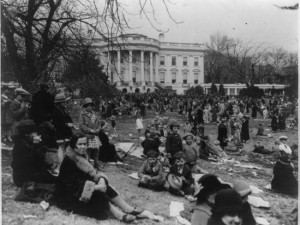Feb
10
Digitized Primary Sources
February 10, 2014 | 1 Comment
Both sources chosen are primary sources which are portrayed through the digital means of a website. One depicts a collection of maps of D.C (source 1) and the other depicts a chronicling of America with a focus of D.C (source 2).
Source 1: The maps depict a variety of information from a general map with distance, to a list of homeowners near their respective property, to bird’s eye views of parts of D.C such as Anacostia. There are hand sketched maps as well as digitally created ones which shows the long standing history D.C holds. In particular, it can be shown that it served as not only a home of the nation’s capitol, but as well as a prospective rebel battle ground with the map of a rebel attack on D.C on catalog. In analysis of this particular source, research went into the credibility of the site to ensure that the documents do come from a trusted source.
Source 2: The newspaper articles provide a large amount of information. The tool bar at the top of the site allows the reader to toggle through various states in order to find particular articles specific to not only the state but a time period as well. These articles are cataloged in the Library of Congress website, but there are more sources provided in order to supplement information if needed. The allowance of the reader to choose particular time periods to view helps piece together history as you can take it time period by time period which puts everything in chronological context and creates a greater understanding. In particular to D.C, it is shown that during the early 1900’s, it was a normal occurrence to have religion put into newspapers. This shows a strong disconnect between the idea of desperation of church and state which is still in disconnect to this day.
Analysis:These sources can be considered credible due to the association the Library of Congress has with accuracy. In context, they serve as crucial pieces of history because the maps and news articles cover a broad range of dates which enable a clearer understanding. During the close reading it was noted that the maps contained homeowner names showing how D.C must have been fairly small in vicinity to have a detailed list of homeowners so readily available.The close reading of the news articles indicate that news companies were more lenient with what was allowed in the papers, especially with the idea of separation of church and state. The maps and news articles can be confirmed as primary sources because they are dated, include a contributor, and come from a reputable source. Both sources were fairly easy to work with.
Source 1: Library of Congress Maps
Source 2: Chronicling America
1 Comment so far


Brittany, you’ve described or reviewed two sources of primary materials, and it’s useful to know what you can find in each of them, but the map collection and Chronicling America aren’t primary sources themselves!